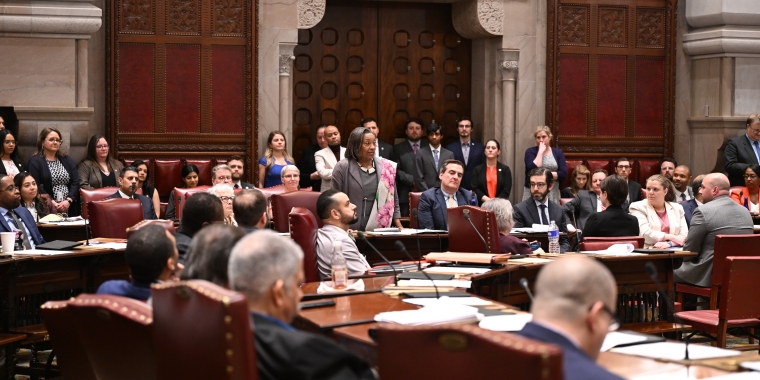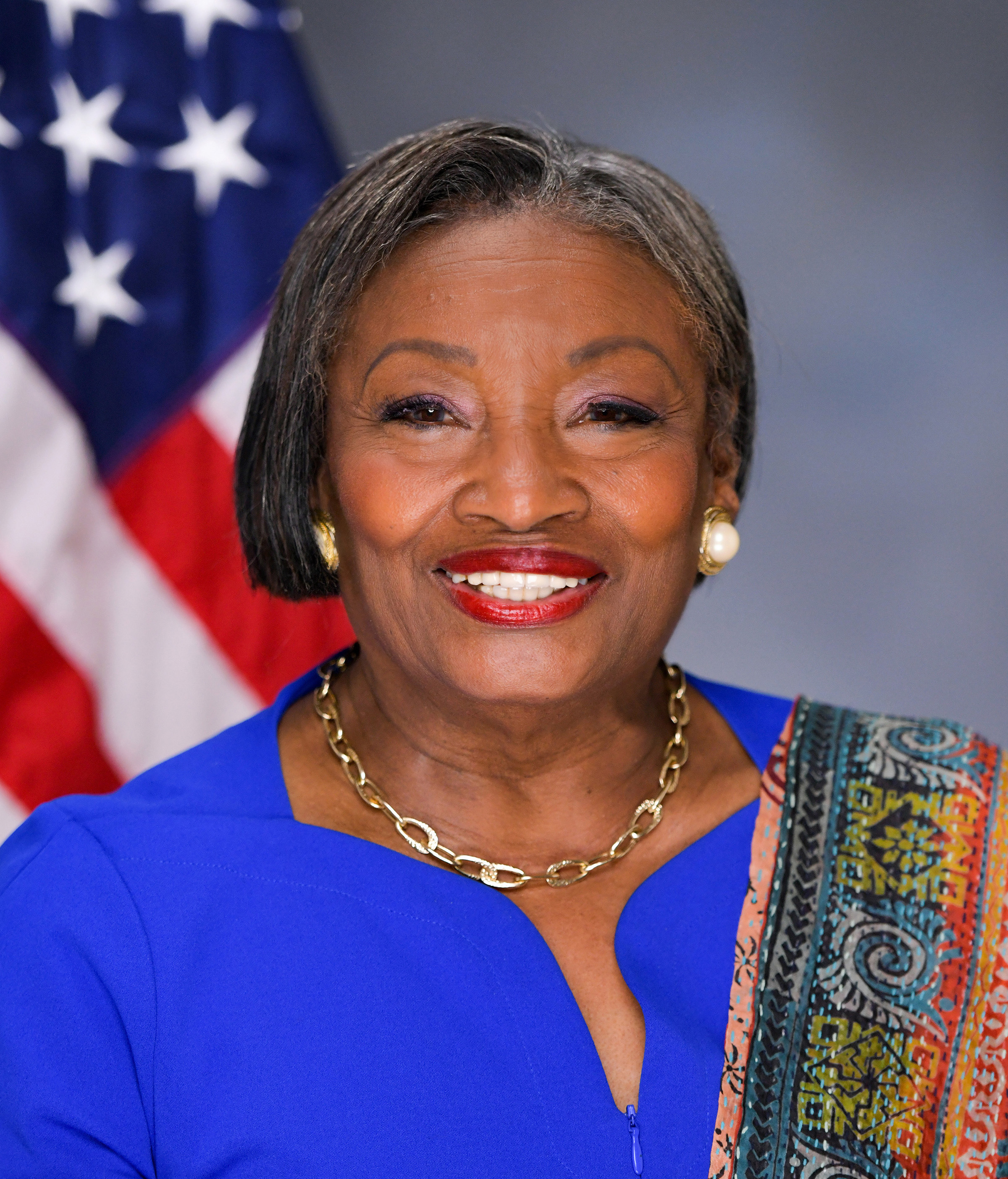Senate Passes 2025-26 Budget Prioritizing Affordability, Shielding New Yorkers from Federal Threats
May 9, 2025
-
ISSUE:
- Housing
- Education
- Taxes
- Transportation

Amid significant uncertainty and looming federal cuts, the New York State Senate passed a State Fiscal Year (SFY) 2025-2026 budget prioritizing affordability and relief to New York’s working families. The strategic financial plan safeguards economic security, prepares the state for potential financial challenges, and makes strategic investments in education, housing, healthcare, public safety, and environmental stewardship to ensure future stability and equity.
Senate Majority Leader Andrea Stewart-Cousins said, “With this budget, we take important steps toward addressing the challenges facing New Yorkers, providing meaningful relief to families, and protecting our state from harmful federal policies. Our proactive approach aims to support New Yorkers today while preparing us for the challenges ahead. I’m proud of the Members of the Senate Majority for their input, advocacy, and relentless efforts on behalf of their constituents and all New Yorkers throughout this difficult budget process. I also thank Governor Hochul and Assembly Speaker Heastie for their partnership in navigating these challenging waters. I look forward to continuing to deliver results for New Yorkers throughout the remainder of this legislative session.”
Deputy Leader Mike Gianaris said, “The State Senate worked tirelessly to craft a budget that serves our communities and delivers tangible benefits for New Yorkers amidst a federal government intent on doing them harm. I am proud that we achieved important policy priorities that will result in putting more money in the pockets of New Yorkers. By lowering middle-class tax rates, expanding the child tax credit, cutting utility costs, and investing in stable, affordable housing, we are making New York a more affordable place to live and thrive. Additionally, we are investing in New York’s public transit systems, keeping our buses and subways running, modernizing infrastructure, and supporting the workers who keep our cities moving. These are just a few of the ways this budget delivers for New Yorkers, ensuring our state remains a place of opportunity and stability.”
Senate Finance Chair, Senator Liz Krueger said, “This budget begins to chip away at the affordability crisis for regular New Yorkers, by cutting taxes for the middle class, reducing the Payroll Mobility Tax for small and medium-sized businesses, expanding the child tax credit, paying off unemployment insurance debt, providing universal free school meals, and finally creating a housing access voucher program pilot. We have been able to achieve this while keeping our fiscal house in order and funding the critical MTA Capital Plan. There is still an immense amount of work to do to address the many crises bearing down on our state, but this budget moves us in the right direction.”
Providing direct financial relief and essential support to New Yorkers, including:
- Directly provides money to New Yorkers in the form of Inflation Rebate Checks as detailed below:
- Married filers: $400 for incomes up to $150,000, $300 for incomes $150,000–$300,000
- Single filers: $200 for incomes up to $75,000, $150 for incomes $75,000–$150,000
- Lowest middle-class tax rates effective from Tax Year 2026
- Cuts taxes for self-employed workers earning up to $150,000 in the MTA region by raising the Payroll Mobility Tax threshold from the current $50,000 threshold
Supporting NY Families:
- $8 million for baby benefits for new families to provide postpartum care packages and $1.5 million to distribute approximately 10 million diapers to families across New York State
- Three-year expansion of the child tax credit, providing $1,000 annually for children under age four and increasing the credit for children aged four and older from $330 in the first year to $500 in the following two years
- $50 million for the Hunger Prevention and Nutrition Assistance Program (HPNAP) and Nourish NY
- $90 million for the Underserved Communities and Civic Engagement Program, which supports community-based programming, crisis intervention initiatives, housing assistance, economic development, workforce training, educational initiatives, and healthcare services in underserved communities
Providing Relief for High Utility Costs:
- $50 million for EmPower Plus to help individuals carry out energy efficient upgrades to their homes so they can decrease their utility costs via the Sustainable Futures Fund
- $25 million in additional funding for HEAP, the Home Energy Affordability Program, which provides the lowest income New Yorkers with direct relief on their heating bills
- $2 million for the Green Affordable Pre-Electrification Program (GAP) Fund to help individuals get needed upgrades to their homes so they can qualify for energy affordability programs
- $2.5 million for the Public Utility Law Project, which advocates for lower energy rates before the Public Service Commission and provides support to New Yorkers with utility-related legal and billing issues
Ensuring access to quality education from early childhood through college, including:
Childcare & Afterschool:
- An additional $400 million, for a total of $2.2 billion, for Child Care Block Grant funding to provide affordable child care across New York State to thousands of families
- Establishes a Child Care Substitute Pool
- $100 million in capital funding for child care centers to allow for expansions and new centers to open
- $10 million in federal funds for family child care renovations
- $21.6 million for youth development programs
- $12.5 million for "Get Offline, Get Outside 2.0"
- $76.5 million for NYPLAYS and $100 million for NYBRICKS
K–12 Education:
- Continues our commitment to record funding for our schools with an additional $120 million increase to Foundation Aid over the Executive’s proposal for a total of $26.4 billion
- Provides a $1.7 billion increase in school aid over last year, including a $1.4 billion year-to-year increase in Foundation Aid
- $59.3 million to expand non-BOCES CTE funding to 9th grade and increases the per-pupil minimum and increases salary reimbursement rates for BOCES teachers so that school districts get the money they need to provide career-ready education to students
- $340 million for full universal school meals
- “Distraction-free learning” cell phone policy in schools
Higher Education:
- Capital funding for SUNY: an additional $160 million for a total of $2.3 billion
- Capital funding for CUNY: an additional $83 million for a total of $580.4 million
- Creates the New York Opportunity Promise Scholarship for New Yorkers aged 25–55 pursuing critical workforce associate degrees
- Expands operational funding for community colleges with an increase of $6 million to SUNY community colleges for a total of $14 million, and $4 million to CUNY for a total of $9.3 million
- Restores Higher Education Opportunity Program (HEOP) funding
Arts & Libraries:
- Fully restores $20 million in operating grants and $40 million in capital grants for arts organizations to the New York State Council on the Arts
- $150,000 for a new pilot program supporting social workers in libraries
- Adds $1.7 million for library operating aid for a total of $106.3 million
- Adds $10 million for library capital grants for a total of $44 million
- Continuing investments in stable, affordable housing for tenants and homeowners, including:
- $50 million annually for the Housing Access Voucher Program (HAVP) pilot, which will provide four years of vouchers distribution to individuals and families who are homeless or at risk of homelessness
- $40 million for the Homeowner Protection Program (HOPP)
- $20 million for eviction legal counseling
- Expands the use and transferability of State Historic Property Tax Credits
- Extends and doubles state Low-Income Housing Credits
- Over $1 billion towards City of Yes initiatives in NYC, including:
- $50 million for Revolving Loan Fund in NYC
- $500 million for new affordable housing construction
- $225 million for NYCHA
- $110 million total for Mitchell-Lama preservation in NYC
- $50 million total for New York Housing for the Future Homeownership and Rental Programs
- $50 million for supportive housing in NYC
- $50 million for lead abatement in NYC
- $20 million for stabilization and preservation of existing affordable or supportive multifamily rental properties in NYC
- Funding for Housing outside NYC, including:
- $50 million outside NYC for a Housing Revolving Loan Fund
- $75 million for public housing outside NYC
- $30 million for Mitchell-Lama preservation outside NYC
- $40 million for the Vacant Rental Improvement Program to bring apartments up to code for use as affordable rentals outside NYC
- $30 million for the Block-by-Block Program to help upstate cities develop one- and two-family infill homes
- $40 million for land banks
- $10 million for Shelter Arrears Eviction Forestallment Program
- $10 million for Small Rental Development Initiative to build small rental buildings in upstate communities
Expanding access to care and strengthening mental health services statewide, including:
- $305 million for Hospital Operating Support
- $223 million for nursing homes and $7.5 million for assisted living programs
- $20 million for Federally Qualified Health Centers
- $500 million restored to distressed hospitals
- $70 million invested in the Opioid Settlement Fund
- $20.5 million additional funding for 200 inpatient mental health beds
- An additional $250 million, for a total of $450 million, for critical infrastructure improvements to SUNY Upstate Hospital, the only level one trauma center serving over a dozen counties
- Extends the Emergency Medical Service Fee Authorization for Fire Departments and Fire Districts for an additional five years, allowing essential services to better provide care throughout the state
- Doubles funding currently available via the Mobile Sports Wagering Program to assist with problem gambling from $6 million to $12 million
Ensuring Access to Reproductive Health Care:
- $70 million for reproductive health initiatives, including:
- $25 million for the Reproductive Freedom and Equity Grant Program
- $25 million for abortion medication care grants
- $15 million for reproductive healthcare facilities capital grants
- $4 million for abortion provider training
- $1 million for abortion access
- Requires hospitals to provide emergency abortion care
- Modernizes pregnancy loss reporting to protect patient privacy
- Expands Medicaid coverage for infertility preservation services
Improving Behavioral Health Crisis Response, Launching Daniel’s Law Pilot Program:
- Establishes Daniel’s Law pilot programs for $6 million and creates the Behavioral Health Crisis Technical Assistance Center with $2 million for implementation
- Clarified involuntary commitment standards for the purposes of delivering care to those in need, while also strengthening guardrails to ensure safe and humane transportation, along with increased training for first responders. The Senate was instrumental in providing greater discharge planning requirements for when people are released from care facilities, a meaningful step in helping connect individuals with longer term services
- Improves Assisted Outpatient Treatment standards (Kendra’s Law) to ensure people get the care they need
- Requires annual review of excessive force incidents during behavioral health responses to create better protocols for response and treatment
Protecting communities, strengthening victims' services, and investing in smart public safety solutions, including:
- Establishes the Office of Gun Violence Prevention within Criminal Justice Services
- Enhances protections for sexual assault and domestic violence victims, including making it easier for survivors to access public assistance and strengthening workplace policies related to gender-based violence
- An additional $1.5 million specifically for gun violence initiatives for a total of $325 million in gun violence prevention funding
- Increases funding for youth and community safety programs
- Updates the state’s discovery laws to ensure cases aren’t thrown out on technicalities and perpetrators are brought to justice by directing judges to assess the prosecutor’s overall efforts and the actual impact of any missing evidence, reducing case dismissals over minor oversights
- An additional $15 million for discovery reform for a total of $135 million
Strengthening safeguards against deceptive practices and protecting New Yorkers’ money, including:
- Regulates “Buy-Now, Pay-Later” (BNPL) loans by establishing first-in-the-nation consumer protections and limiting fees and interest
- Expands standardized retail return policies to include online retailers
- Enhances transparency for subscriptions with mandatory multiple cancellation options
- Requires disclosure for dynamic pricing algorithms
Expanding state contracting opportunities and providing essential relief to New York's job creators, including:
- Pays off the $8 billion unemployment insurance debt, helping to provide relief from high fees and taxes for businesses across New York State, which had to lay off employees due to the COVID-19 pandemic
- Extends the state’s MWBE program by three years and commissions a new policy study to consider other ways to improve program participation and mentoring
- Expands the discretionary bidding threshold for all state agencies from $750,000 to $1.5 million, and expands the discretionary bidding threshold for state authorities from $500,000 to $1.5 million to increase MWBE and service-disabled veteran participation in state contracts
Delivering targeted relief and opportunity for New York’s workforce, including:
- Fully pays off unemployment insurance (UI) debt; increases UI benefits from current $504 per week to $869 per week, and then to 50% of state average weekly wage starting October 2026
- 2.6% targeted inflationary increase for human services workers at O agencies
- Enhances enforcement against wage theft
- Increases penalties for child labor violations
- Decreases the waiting period for striking workers to collect unemployment insurance
- Extends the civil service exam fee waiver to December 31, 2027
- Expands apprenticeship programs in high-demand sectors
- Provides long overdue pension reform for members of law enforcement, including:
- 20-year retirement for Tier 3 NYPD officers
- 20/25-year retirement for New York State Forest Rangers, New York State Park Police, State University of New York (SUNY) Police, and Environmental Conservation Officers
- An increased final average salary for retiring detectives, lieutenants, and sergeants of the NYPD
- Codifies the Healthy Terminals Act effective January 1, 2026, including part-time workers
Advancing environmental protections and sustainability, including:
- $1 billion in climate resiliency and green energy funding through the Sustainable Futures Fund, including:
- $450 million for building greenhouse gas emissions, including:
- $200 million for thermal energy projects at SUNY and CUNY
- $50 million for Clean Green Schools, and for the purchase and installation of energy efficient equipment at single family residences, multi-unit residential apartment buildings, and residential premises owned as a residential cooperative apartment or condominium unit
- $40 million for municipal thermal energy projects
- $250 million for zero-emission transportation, including:
- $100 million for zero-emission transportation, including school buses and supporting infrastructure
- $50 million for EV fast charging stations and supporting infrastructure for municipal, commercial, medium duty, heavy duty, and fleet vehicles
- $50 million for NYSERDA Charge Ready NY Program
- $200 million for renewable energy projects
- $100 million in additional unallocated funding
- $1.7 billion for the 50-year Fire Island to Montauk Point Project (FIMP)
- $500 million for clean water grants
- $425 million for the largest Environmental Protection Fund in state history
- Increases the Geothermal Tax Credit from $5,000 to $10,000 and adds refundability as an option for certain taxpayers
- Bans PFAS in personal protective equipment for firefighters starting in 2028 and ensures disposal of this PFAS is environmentally sound
- $450 million for building greenhouse gas emissions, including:
Modernizing transit, strengthening road safety, and building infrastructure for the future, including:
- Increases funding for the Consolidated Local Street and Highway Improvement Program (CHIPs) by $50 million over the Executive’s proposal for a total of $100 million over the next two years
- $5 million increase over the Executive's proposal for non-MTA STOA for a total of $907.8 million
- Extends the Automated Work Zone Speed Enforcement Program by five years and expands it to include more work zones on state roads and the Thruway; expands the pilot program to include Bridge Authority and Triborough Bridge and Tunnel crossings
- Fully funds the MTA’s 2025–29 Capital Program, including $3 billion in direct state commitment and reducing the MTA’s borrowing costs
Securing the future of New York’s farms, farmworkers, and food systems, including:
- Increases funding for farmworker housing and overtime credits
- Increases funding for farmland protection by $4 million for a total of $25 million in the Environmental Protection Fund (EPF)
- Includes a carve out of $1 million for capacity grants for local agricultural farmland protection planning
- Increases farmworker housing loan cap from $200,000 to $400,000 per project
- Restores millions to bedrock farm programs
Improving veteran and family support services, including:
- Expands eligibility and outreach requirements for Gold Star Annuity
- Enhances veterans' services
- $8 million in Dwyer funding
- $350,000 for Veterans Mental Health Training Initiative (VMHTI)
related legislation
Share this Article or Press Release
Senators Involved
35th Senate District
12th Senate District
28th Senate District


